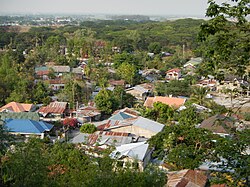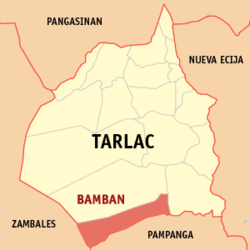Bamban, Tarlac
| Bamban | ||
|---|---|---|
| Municipality | ||
 |
||
|
||
 Map of Tarlac showing the location of Bamban |
||
| Location within the Philippines | ||
| Coordinates: 15°39′N 120°15′E / 15.65°N 120.25°ECoordinates: 15°39′N 120°15′E / 15.65°N 120.25°E | ||
| Country | Philippines | |
| Region | Central Luzon (Region III) | |
| Province | Tarlac | |
| District | 3rd District | |
| Founded | 1710 | |
| Barangays | 15 | |
| Government | ||
| • Mayor | Jose Antonio Tiglao Feliciano | |
| Area | ||
| • Total | 251.98 km2 (97.29 sq mi) | |
| Population (2015 census) | ||
| • Total | 69,466 | |
| • Density | 280/km2 (710/sq mi) | |
| Time zone | PST (UTC+8) | |
| ZIP code | 2317 | |
| IDD : area code | +63 (0)45 | |
| Income class | 2nd class | |
| Website | bambantarlac |
|
Bamban is a second class municipality in the province of Tarlac, Philippines. According to the 2015 census, it has a population of 69,466 people.
The municipality of Bamban is the southernmost gateway of the melting pot province of Tarlac in the Central Plain of Luzon in the Philippines.
Being the southernmost town in the province, it has a common boundary with Mabalacat, Pampanga, and in the west, with Zambales. The boundary is defined by the Parua River, which is a source of irrigation water, food, and sand and gravel for infrastructure projects. The mountainous region situated in the western part comprises almost two-thirds of the total land area, which used to be within the US Military Reservations. Nestled in this part are the BLISS projects and to the north, the MAR settlement project, which when completely developed will be a source of livelihood and food supplies for Central Luzon.
Bamban is politically subdivided into 15 barangays.
Long before settlers came, the place which was to become the town of Bamban, was a vast track of wild land extending eastward; and on the west side, composed of foothills and mountains lush with vegetation and tall trees extending deep into the Zambales ranges. The thick forest and mountains were then inhabited by the Aetas (locally known as Baluga), and the Zambal, both of whom subsisted only on fishing and native or wild animals which abounded in the place. Occasionally, daring traders from Pampanga and the Tagalog province, mostly enterprising Chinese, braved the wilderness to go northward to Capas and Tarlac.
Before the advent of the Spanish era, small settlers came, attracted by the fertile land and the glittering silver of the river that cut through the mountain to spill down the flat land, making it fertile. The settlers started small clearings in the thick growth of bamban plants which covered vast portions of the land bordering the river a small distance from the foothills.(because of these plants, the place was eventually named Bamban).
Settlers upon settlers came to carve clearings in the land, and soon a small community was formed. About 1700, Agustinian Recollects came and established the Mission de Pueblos de Bamban. But the pueblo was then a part of Pampanga. In 1837, a new boundary line was established, thereby permanently making Bamban part of the province of Tarlac.
...
Wikipedia


